The gulf between North American and European market performance was wide in all manufactures in the 1980s, but no where did it feel more vast than with the Audi products. That was especially true with the turbocharged variants of the large chassis. In European guise, the Type 200 5T developed 170 horsepower even without an intercooler, while the U.S. 5000 Turbo managed only 130 from the 2.1 liter inline-5. That was a 24% drop in performance, and it didn’t get much better with the Type 44 replacement. Though displacement later grew to 2.2 liters in the MC1 and 2 codes, power output never exceeded 162 horsepower. That meant that the 1987 Audi 5000CS Turbo (and the turbocharged quattro model) produced only about 81% of its European equivalent’s power output.
Despite that, the 5000 was a great sedan. It was quite, comfortable, and more modern-feeling than its contemporaries. It was also good enough for notorious BMW-friendly Car and Driver to add it to their 10-Best list – even without the trademark all-wheel drive. With weight fairly far in excess of 3,000 lbs, the luxury sedan wasn’t a rocket off the line, but on the roll it was a competent and quiet cruiser. Audi claimed the automatic-equipped Turbo model would hit 60 mph in 8.7 seconds and flat out would do 130 mph – numbers that were barely better than its normally aspirated smaller brother Coupe and 4000S front-drive models (themselves not particularly notable for being quick!). But thanks to some notoriety in Ferris Bueller’s Day Off and great press (ahem – well, for a bit anyways!), these Audis sold fairly well. For example, compared to the 4000 quattro and Coupe GT models, the 5000 Turbo was traded in much greater numbers despite its high price. In 1987, Audi sold just shy of 2,000 Coupe GT models and nearly 3,000 4000CS quattros. But the Turbo? They sold 6,849 of them. Why are they so rare to see then?

